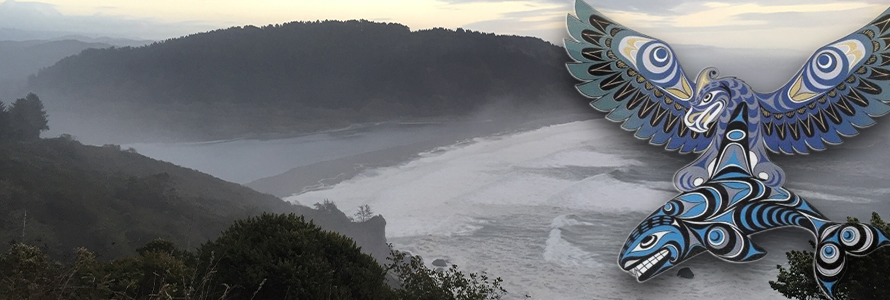Thunderbird and Whale was the first-ever national-level exercise fully planned and executed by tribal nations. Lynda Zambrano, Executive Director of the National Tribal Emergency Management Council, recounts her team’s approach to the exercise and how they maximized resources to benefit tribal communities in the Pacific Northwest.
Tribal nations take the lead
The Thunderbird and Whale exercise simulated the scenario of a 9.0 earthquake and a resulting 100-foot tsunami so tribal first responders could practice responding to a catastrophic disaster.
The exercise covered the area along the Cascadia fault line, spanning from northern California to Alaska, including jurisdictions as far north as British Columbia and as far east as Montana. Satellite communications hubs were also set up in Florida, Virginia, and Southern California to support the operations.
FEMA was planning to conduct its traditional Cascadia Rising national-level exercise as a discussion-based engagement. Tribal public safety organizations wanted to take this a step further with a full-scale exercise.
The natural choice to plan and execute the exercise was the National Tribal Emergency Management Council, a network of tribal nations that promote emergency management best practices.
“Our organization was asked if we would take the lead on a national-level, full-scale functional exercise for the tribes so they could physically engage and exercise their comprehensive emergency management plans,” said Zambrano.
The catch was that instead of the typical 2-4 years to prepare for a national-level exercise, the tribes had six months and no funding. Zambrano said, “A real-life event will not take vacation or wait on us, so we felt it was imperative that we do this for our tribes.”
The story of Thunderbird and Whale
Once tribal nations took the lead, they changed the name of the exercise to Thunderbird and Whale to reflect a traditional story within Pacific Northwest tribes that dates back thousands of years.
Zambrano told us her version of the story and how it is important to the exercise:
“Thunderbird soared far out over the placid waters of the ocean. As quick as a flash, the powerful bird darted and seized Whale in its flinty talons and soared away toward the land.
Thunderbird carried Whale to its nest in the lofty mountains. The two fought a terrible contest, resulting in shaking and trembling of the earth beneath (representing the earthquake) and a rolling of the great waters (representing the tsunami).”
With a new name reflecting their heritage, the tribes jumped into action to plan a realistic exercise that would benefit the community.
Communications as a priority
With only six months to plan, the tribes initially focused on communications. Communications is one of 15 emergency support functions identified by FEMA as most needed in a national response to a disaster.
To keep things realistic, the tribes simulated zero communications after the earthquake hit. “We told everybody they had to turn off their cell phones and couldn’t use their laptops or answer email or text messages,” said Zambrano.
The plan for initial communications were ham radios, which don’t rely on infrastructure like towers and can use batteries or solar power. The next critical step was to get a FirstNet deployable on site.
Using ham radios to send an email via radio pathways, they contacted the FirstNet Response Operations Group at AT&T. The group, led by former first responders, guides the deployment of the FirstNet deployable assets based on the needs of public safety. They are responsible for sending out deployables, such as FirstNet SatCOLTs (satellite cell on light trucks), to provide connectivity via satellite.
“The assumption was that, due to the earthquake, we had no cellular communications and very limited email and data until a SatCOLT arrived,” said Zambrano.
FirstNet deployables are stationed around the country and can be on site within 14 hours of the initial request. “I am very proud and happy to report that everything ran extremely smoothly, and the support was there and on time,” she said. “By the following day, we were able to initiate cell phone, email, and internet traffic.”
Communications are one of the most valuable tools in responding to disasters. “The FirstNet SatCOLT was a critical piece of equipment for us to be able to communicate with the outside world during the disaster,” said Zambrano. “Without it, we would have been dead in the water for a very long time.”
The SatCOLT also came with a cache of FirstNet devices that responders were able to test in real time, using features like push-to-talk.
Exercise benefits the community
With communications secured, the tribes expanded the exercise to encompass all 15 emergency support functions. “This truly became a full-scale exercise,” said Zambrano.
Thunderbird and Whale used the exercise’s resources to directly assist communities in the Pacific Northwest. Pilots—who volunteered to provide transportation for the exercise’s food distribution agencies—distributed 80,000 pounds of food, water, and supplies to coastal tribal nations and local food banks, just as they would in a real disaster.
Another benefit of the exercise was that participating tribes learned best practices for emergency management from each other.
“One of the tribes engaging in this exercise saw what we were doing and said, ‘Why are we not working with FirstNet?’ And they immediately had FirstNet come out and do a presentation. Now they're shifting all their first responders to FirstNet,” said Zambrano.
She stressed that, even considering all the other benefits, the real point of the exercise was saving lives.
“I really wanted to bring the focus back to the number of lives that were saved by conducting this exercise,” said Zambrano. “If we don't talk about the number of lives saved, then we've lost the point of having communications.”
FirstNet Authority exercise support
The Thunderbird and Whale exercise used a template from the Homeland Security Exercise and Evaluation Program (HSEEP) planning documents. The FirstNet Authority offers support to emergency managers preparing similar plans through our Network Experience Engagement Program (NEEP), which includes:
- Pre-incident or event support
- An exercise inject catalog
- Post-incident or event reviews
If you’re interested in learning more about how to best use broadband during disasters or large events, contact your FirstNet Authority Public Safety Advisor.




















